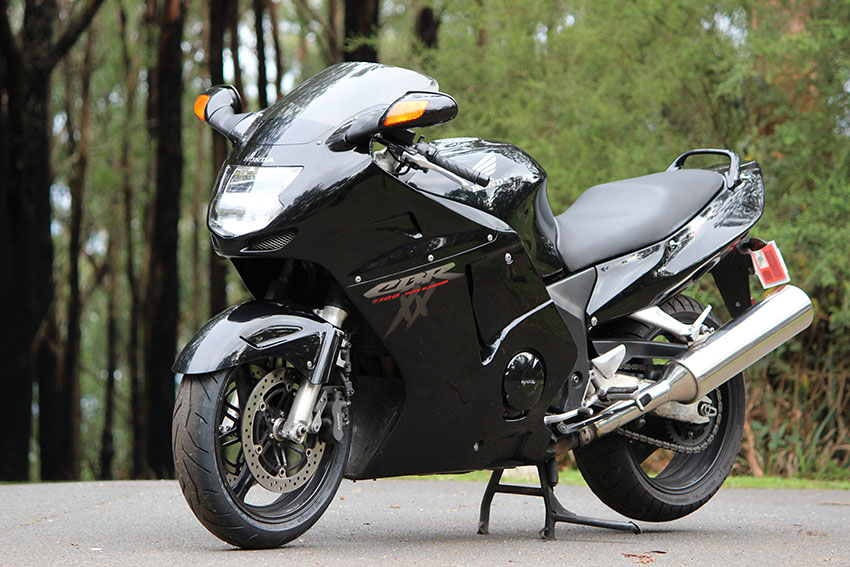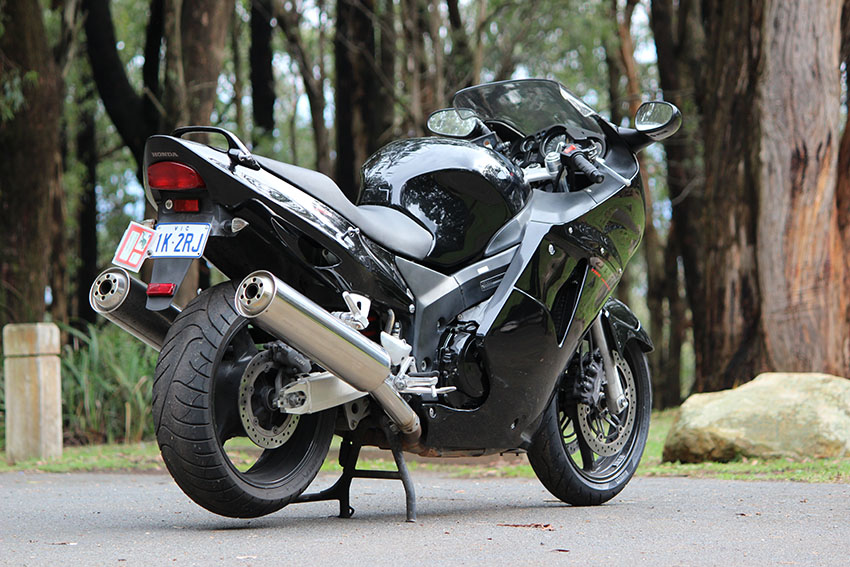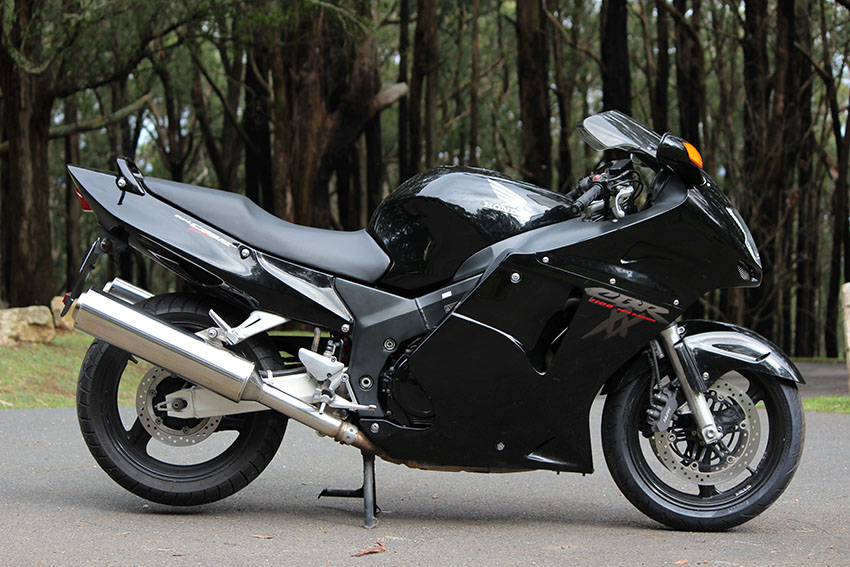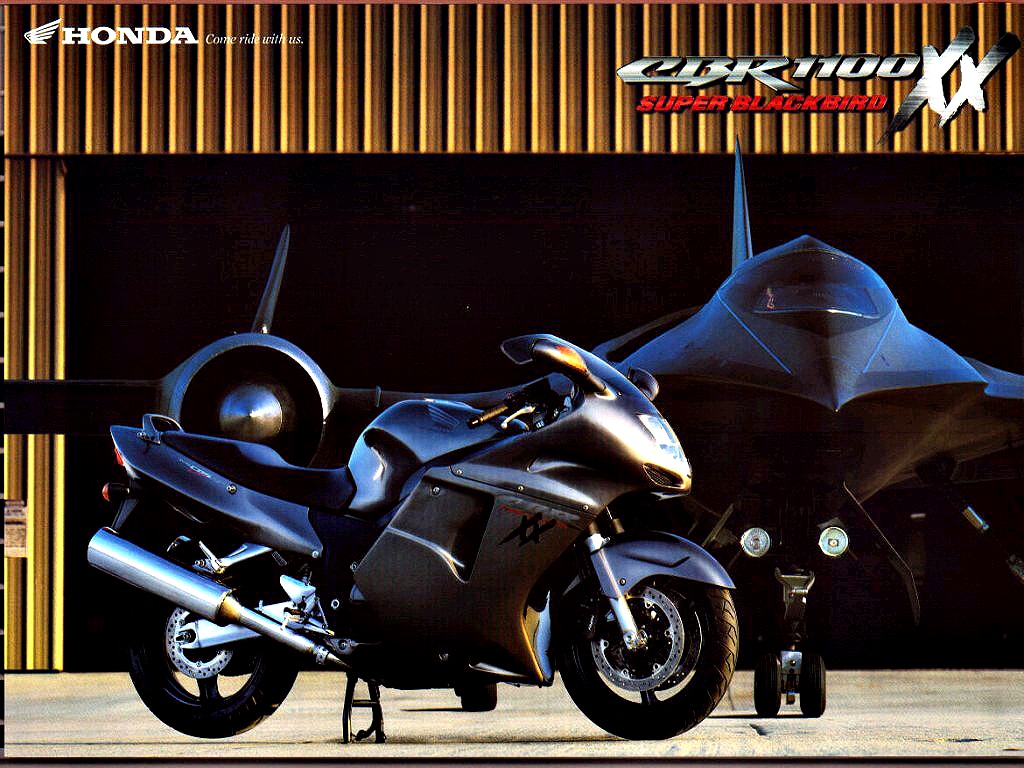Motorcycle Investor mag
Subscribe to our free email news

Our Bikes – 1996 Honda CBR1100XX Super Blackbird
by Guy ‘Guido’ Allen, December 2020

The Homing Blackbird
Pondering a long-term relationship, that’s twice been rekindled
Maybe I was distracted. Ms M Snr was talking about an upcoming ride to the Lemmings Motorcycle Club resort – otherwise known as the Tintaldra pub – and announced she wanted a fresh mount, thanks, something she hadn’t ridden before. While this begs the question of what she imagines my motorcycle conjuring powers are like, I casually blurted, “You might as well take the Blackbird.”
“What Blackbird?!” was the instant response. Oops.
Dunno if you’ve noticed this, but there’s no delete button on conversation – a pity, really. I won’t bore you with the rest of the somewhat awkward discussion, let’s just move on to the bike.
ON A MISSION
Back in the mid nineties, Honda was on a mission to gain the upper hand in the ultimate muscle bike race and the Super Blackbird – named after Lockheed’s ultra-fast (3900km/h-plus) SR-71 spy plane – was the result. On launch in late 1996, the 164 horsepower missile was scoring top speeds up to 290km/h, enough to claim the crown as the quickest production bike in the world.
Suzuki came along two years later and crashed the party with its 300km/h-plus Hayabusa. As an illustration of the cruelty of the corporate world, Hamamatsu’s name for the GSX1300R was a little ‘in’ joke. You see a Hayabusa is a Peregrine Falcon, which eat Blackbirds – or at least the feathered variety.
(A quick note here: though I now have both a ’Busa and a ’Bird in the shed, there’s so far no evidence of violence…)
The two-deck front headlight was a wild styling departure at the time, but underneath the bodywork the machine was relatively conventional. A liquid-cooled inline four, with four valves per pot, was fed by CV carbs, and worked a six-speed transmission via a wet clutch, with chain final drive.
The chassis too, held few surprises, that is if you ignore the braking. Employing a fairly sophisticated linked system with a series of apportioning valves, running three-piston calipers all round, it was the source of some controversy.
The bike squats nicely under full braking on a level surface, but the rear (on generation one bikes) can break away with the use of the front lever only on steep downhills, admittedly under extreme circumstances. Also, the system could feel clumsy when you were going for the foot brake only during slow and tight manouvres.
The overall feel was much improved with the second generation Blackbird (1999-2000). I’ve never been a huge fan of the system, and often a critic, though that hasn’t stopped me from buying three Blackbirds over the years!
Okay, what’s so good about them? Even now, the combination of silky smooth power delivery, stunning performance and one of the most user-friendly sports-touring ride positions ever invented, makes them a compelling motorcycle.

Though hardly a stranger to high-performance street bikes, and Blackbirds, in the first couple of days of getting acquainted with this bike I’d sometimes glance at the speedo and be appalled to find we were traveling much quicker than expected. Put it down to the uncannily smooth engine and an amiable if not particularly sharp chassis.
The only disappointment with the first, carburetor, version of the engine was an annoying mid-range flat spot. It had no major impact on performance and can be tuned out. That sort of behaviour was not unique at the time, as manufacturers worked their way around drive-by noise tests. In any case the issue was comprehensively fixed with the fuel-injected series.
I’ve owned both fuel-injected versions and this was the first time I’d ridden a carb bike since they were first launched. The smoothness is uncanny and the fuel consumption modest at around 16km/lt. At some stage, though, I’m going to get the thing together with a decent dyno tuner and see if we can fix that flat spot.
Steering is very predictable with a light tip-in and a willingness to hold a set line. Though it weighs a claimed 225kg dry, it feels low and relatively light. Suspension adjustment is minimal, with nothing up front, and rebound damping on the nitrogen-charged rear. The spring and damping rates are chosen for the street rather than the track, with a touch of comfort.

IN THE MARKET
While the Blackbird lost its performance crown in a couple of years, it remained a popular choice among folk looking for a big fast sports tourer – with good reason. It was better finished than the Hayabusa, a little more user-friendly in some respects, and still very quick. You can see the appeal.
Over the years they’ve built a justifiable reputation for being mechanically robust and wearing the trials of time and use very well. A ’Bird with over 100,000km is far from worn out.
Used examples are plentiful, priced from just $3500 (with well over 100,000km) up to around $10k. The first injected version is the pick of the litter as a performance ride.
This time around, I particularly wanted a first edition, with black paint. Call me a nut, but I reckon a good first edition is worth having and holding on to. With about 56,000km on the clock it’s a long way from feeling tired.
Was it money well spent? Yup. It’s quick, smooth and comfortable, even all this time down the track and nearing 25 years old. It’s really nice to have one in the shed. It is often my default ride when I want something that's quick and easy to just hop on and go. Not so much a homing pigeon as a homing Blackbird. And, like my first, it’s called Bronson.

See more 'Our Bikes' stories here
***
See the video
Know your Blackbird
Blackbirds were built from 1996 (for the 1997 model year) through to 2007. There were three generations:
1997-1998: Carburettors, 22 litre fuel tank, 164hp claimed;
1999-2000: Injected, 24 litre fuel tank, two-deck tail-light, 164hp claimed;
2000-2007: Mixed analogue/digital dash, catalytic converter, 152hp claimed.
Several other running changes were made, for example a new front hub and discs between gen 1 and 2, plus alterations to the set-up of the linked brake system.
Father of the Blackbird
You may not have met Isao Yamanaka, but there's a fair chance you've either ridden one of his products, or know someone who has.
Yamanaka san has been involved in all sorts of weird and wonderful machinery: relatively pedestrian stuff such as CB900 Bol d'Or and the first of the VF V-four series, or exotica such as the eight-valve NR oval-piston project.
He joined Honda as an engineer in 1974 – in the research and development division – and (when we last interviewed him in 2000) moved on to become a project leader. That means he pulled together the various aspects of a machine, such as chassis and powerplant, to end up with a marketable whole.
A keen motorcyclist, he confessed to enjoying football and beer.

SPECS:
Honda CBR1100XX Blackbird
ENGINE:
TYPE: Liquid-cooled, four-valves-per-cylinder, inline four
CAPACITY: 1137cc
BORE & STROKE: 79 x 58mm
COMPRESSION RATIO: 11:1
FUEL SYSTEM: 42mm Keihin CV carbs or Honda fuel injection
TRANSMISSION:
TYPE: Six-speed, constant-mesh,
FINAL DRIVE: Chain
CHASSIS & RUNNING GEAR:
FRAME TYPE: Aluminium twin-spar
FRONT SUSPENSION: Cartridge telescopic fork, 120mm travel
REAR SUSPENSION: Preload-adjustable & rebound dampingvs adjustable monoshock, 120mm travel
FRONT BRAKE: 310mm discs with three-piston calipers DCBS
REAR BRAKE: 256mm disc with three-piston caliper DCBS
DIMENSIONS & CAPACITIES:
DRY/WET WEIGHT: 223/254kg
SEAT HEIGHT: 810mm
WHEELBASE: 1490mm
FUEL CAPACITY: 22 or 24lt
WHEELS & TYRES:
FRONT: 3-spoke cast alloy , 120/70 ZR17
REAR: 3-spoke cast alloy, 180/55 ZR17
PERFORMANCE:
POWER: 122kW @ 10,000rpm (113kW in third edition with Cat)
TORQUE: 124Nm @ 7250rpm
OTHER STUFF:
PRICE WHEN NEW: $16,500 (1997)
Good:
Fast
Comfortable
Well made
Not so good
Not ideal as a track bike
-------------------------------------------------
Produced by AllMoto abn 61 400 694 722
Privacy: we do not collect cookies or any other data.

Archives
Contact




